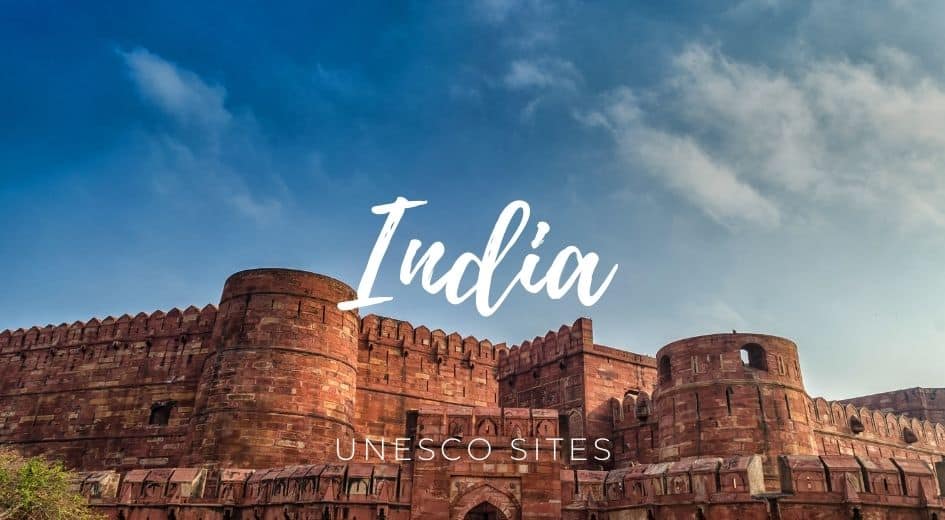Table of Contents


India UNESCO has registered 40 sites on the World Heritage list and 52 on the tentative list.
Some places are so interesting that it’s relevant to keep them for future generations. This is why UNESCO has built a list of crucial classified properties in which superb places stand out for their aesthetic, natural, artistic, or cultural significance.
More than a thousand places are registered as Unesco’s World Heritage worldwide. Due to my interest in visiting World Heritage sites, I compiled the UNESCO list in India and the corresponding map.
India UNESCO list
- Agra Fort
- Ajanta Caves
- Archaeological Site of Nalanda Mahavihara at Nalanda, Bihar
- Buddhist Monuments at Sanchi
- Champaner-Pavagadh Archaeological Park
- Chhatrapati Shivaji Terminus (formerly Victoria Terminus)
- Churches and Convents of Goa
- Dholavira: a Harappan City
- Elephanta Caves
- Ellora Caves
- Fatehpur Sikri
- Great Living Chola Temples
- Group of Monuments at Hampi
- Group of Monuments at Mahabalipuram
- Group of Monuments at Pattadakal
- Hill Forts of Rajasthan
- Historic City of Ahmadabad
- Humayun’s Tomb, Delhi
- Jaipur City, Rajasthan
- Kakatiya Rudreshwara (Ramappa) Temple, Telangana
- Khajuraho Group of Monuments
- Mahabodhi Temple Complex at Bodh Gaya
- Mountain Railways of India
- Qutb Minar and its Monuments, Delhi
- Rani-ki-Vav (the Queen’s Stepwell) at Patan, Gujarat
- Red Fort Complex
- Rock Shelters of Bhimbetka
- Sun Temple, Konârak
- Taj Mahal
- The Architectural Work of Le Corbusier, an Outstanding Contribution to the Modern Movement
- The Jantar Mantar, Jaipur
- Victorian Gothic and Art Deco Ensembles of Mumbai
- Great Himalayan National Park Conservation Area
- Kaziranga National Park
- Keoladeo National Park
- Manas Wildlife Sanctuary
- Nanda Devi and Valley of Flowers National Parks
- Sundarbans National Park
- Western Ghats
- Khangchendzonga National Park
India UNESCO Map
Click on the blue pins to view more relevant information about each World Heritage site in India.
Description
- Agra Fort: A historical fort in Agra, India, built during the Mughal era and known for blending Indian and Islamic architectural styles.
- Ajanta Caves: A series of Buddhist rock-cut cave monuments in Maharashtra, India, dating back to the 2nd century BCE and featuring unique art and sculptures.
- Archaeological Site of Nalanda Mahavihara at Nalanda, Bihar: A complex of ancient Buddhist monasteries and temples in Bihar, India, that was a center of learning from the 5th to 12th centuries CE.
- Buddhist Monuments at Sanchi: A collection of Buddhist monuments in Sanchi, India, including stupas, temples, and pillars, dating back to the 3rd century BCE and representing an important period in Buddhist art and architecture.
- Champaner-Pavagadh Archaeological Park: A UNESCO World Heritage Site located in Gujarat, India, featuring the ruins of the ancient city of Champaner and the nearby Pavagadh hill, with religious and military structures dating back to the 8th century.
- Chhatrapati Shivaji Terminus (formerly Victoria Terminus): A historic railway station in Mumbai, India, known for its blend of Victorian Gothic and Indian architectural styles.
- Churches and Convents of Goa: A collection of churches and convents located in Goa, India, reflecting the influence of Portuguese colonial architecture.
- Dholavira: a Harappan City: The ruins of an ancient city belonging to the Harappan civilization, located in Gujarat, India, featuring an advanced water management system and sophisticated urban planning.
- Elephanta Caves: A network of rock-cut caves on Elephanta Island in Mumbai Harbour, India, featuring ancient sculptures and artwork related to Hinduism and Buddhism.
- Ellora Caves: A network of Buddhist, Hindu, and Jain rock-cut temples and monasteries in Maharashtra, India, featuring unique carvings and sculptures.
- Fatehpur Sikri was built by Mughal Emperor Akbar in the 16th century and served as his capital.
- Great Living Chola Temples are a group of three Hindu temples built during the Chola dynasty in the 11th and 12th centuries in Tamil Nadu.
- Group of Monuments at Hampi is a collection of Hindu temples and palaces once part of the Vijayanagara Empire in Karnataka.
- Group of Monuments at Mahabalipuram is a collection of 7th- and 8th-century CE monuments, including temples, rock carvings, and a lighthouse, built by the Pallava dynasty.
- Group of Monuments at Pattadakal is a collection of 8th- and 9th-century CE Hindu and Jain temples in Karnataka, built in the Chalukya style.
- Hill Forts of Rajasthan are a group of six hill forts in Rajasthan built between the 5th and 18th centuries CE.
- Historic City of Ahmadabad is a walled city in Gujarat that served as the capital of the Gujarat Sultanate in the 15th century and has a rich architectural heritage.
- Humayun’s Tomb, Delhi is a Mughal-era tomb built in the mid-16th century that is a fine example of early Mughal architecture.
- Jaipur City, Rajasthan is a planned city built in the early 18th century that served as the capital of the princely state of Jaipur.
- Kakatiya Rudreshwara (Ramappa) Temple, Telangana is a 13th-century CE temple dedicated to Lord Shiva, a masterpiece of Kakatiya architecture.
- Khajuraho Group of Monuments is a collection of Hindu and Jain temples built by the Chandela dynasty between the 9th and 12th centuries CE, known for their erotic sculptures.
- The Mahabodhi Temple Complex at Bodh Gaya is a Buddhist pilgrimage site and a UNESCO World Heritage Site in Bihar. It is believed to be the location where Gautama Buddha attained enlightenment.
- Mountain Railways of India are a UNESCO World Heritage Site that comprises three railway routes in the Indian Himalayas, namely the Darjeeling Himalayan Railway, the Nilgiri Mountain Railway, and the Kalka-Shimla Railway.
- Qutb Minar and its Monuments, Delhi is a UNESCO World Heritage Site with a towering 73-meter-high minaret and several other significant monuments, including a mosque and a tomb, all located in the Qutb complex Delhi.
- Rani-ki-Vav (the Queen’s Stepwell) at Patan, Gujarat is a unique example of a subterranean water management system and a UNESCO World Heritage Site.
- The Red Fort Complex is a UNESCO World Heritage Site in Delhi. It is a grand fortification built during the Mughal era and is now a popular tourist attraction.
- The Rock Shelters of Bhimbetka are a UNESCO World Heritage Site in Madhya Pradesh, containing the oldest prehistoric art of India.
- The Sun Temple, Konark is a 13th-century temple in Odisha famous for its intricate and impressive architecture, particularly the stone carvings of animals and mythological creatures.
- The Taj Mahal is a mausoleum built by the Mughal emperor Shah Jahan for his wife Mumtaz Mahal. It is located in Agra and is considered one of the most beautiful buildings in the world.
- The Architectural Work of Le Corbusier, an Outstanding Contribution to the Modern Movement, is a UNESCO World Heritage Site that recognizes the works of the Swiss-French architect Le Corbusier in India.
- The Jantar Mantar, Jaipur is a collection of 19 astronomical instruments built in the early 18th century by the Rajput king Sawai Jai Singh II. It is a UNESCO World Heritage Site.
- The Victorian Gothic and Art Deco Ensembles of Mumbai is a UNESCO World Heritage Site that comprises two distinct architectural styles from the colonial era of Mumbai.
- Great Himalayan National Park Conservation Area: Located in the northern Indian state of Himachal Pradesh, this park is home to a diverse range of flora and fauna, including several endangered species.
- Kaziranga National Park: Located in the Indian state of Assam, this park is home to the world’s largest population of one-horned rhinoceroses and many other endangered species.
- Keoladeo National Park: Also known as Bharatpur Bird Sanctuary, this park is located in the Indian state of Rajasthan and is home to many migratory birds.
- Manas Wildlife Sanctuary: Located in the Indian state of Assam, this sanctuary is home to a wide variety of flora and fauna, including several endangered species such as the Bengal tiger and Indian rhinoceros.
- Nanda Devi and Valley of Flowers National Parks: Located in the northern Indian state of Uttarakhand, these parks are known for their scenic beauty and unique alpine flora and fauna.
- Sundarbans National Park: Located in the Indian state of West Bengal, this park is home to the largest mangrove forest in the world and is also home to several endangered species, including the Bengal tiger.
- Western Ghats: This range of mountains runs parallel to the western coast of India and is home to a diverse range of flora and fauna, including several endemic species.
- Khangchendzonga National Park: Located in the Indian state of Sikkim, this park is home to the third-highest mountain in the world and is known for its unique alpine flora and fauna.
UNESCO World Heritage Sites in India have protected places for their cultural and natural importance.
Sites on the Tentative List
- Temples at Bishnupur, West Bengal
- Mattanchery Palace, Ernakulam, Kerala
- Group of Monuments at Mandu, Madhya Pradesh
- Ancient Buddhist Site, Sarnath, Varanasi, Uttar Pradesh
- Sri Harimandir Sahib, Amritsar, Punjab
- River Island of Majuli in midstream of Brahmaputra River in Assam
- Namdapha National Park
- Wild Ass Sanctuary, Little Rann of Kutch
- Neora Valley National Park
- Desert National Park
- Silk Road Sites in India
- Santiniketan
- The Qutb Shahi Monuments of Hyderabad Golconda Fort, Qutb Shahi Tombs, Charminar
- Mughal Gardens in Kashmir
- Delhi – A Heritage City
- Monuments and Forts of the Deccan Sultanate
- Cellular Jail, Andaman Islands
- Iconic Saree Weaving Clusters of India
- Apatani Cultural Landscape
- Sri Ranganathaswamy Temple, Srirangam
- Monuments of Srirangapatna Island Town
- Chilika Lake
- Padmanabhapuram Palace
- Sacred Ensembles of the Hoysala
- Sites of Saytagrah, India’s non-violent freedom movement
- Thembang Fortified Village
- Narcondam Island
- Moidams – the Mound-Burial system of the Ahom Dynasty
- Ekamra Kshetra – The Temple City, Bhubaneswar
- The Neolithic Settlement of Burzahom
- Archaeological remains of a Harappa Port-Town, Lothal
- Mountain Railways of India (Extension)
- Chettinad, Village Clusters of the Tamil Merchants
- Bahá’í House of Worship at New Delhi
- Evolution of Temple Architecture – Aihole-Badami- Pattadakal
- Cold Desert Cultural Landscape of India
- Sites along the Uttarapath, Badshahi Sadak, Sadak-e-Azam, Grand Trunk Road
- Keibul Lamjao Conservation Area
- Garo Hills Conservation Area (GHCA)
- The historic ensemble of Orchha
- Iconic Riverfront of the Historic City of Varanasi
- Temples of Kanchipuram
- Hire Benkal, Megalithic Site
- Bhedaghat-Lametaghat in Narmada Valley
- Satpura Tiger Reserve
- Serial Nomination of Maratha Military Architecture in Maharashtra
- Geoglyphs of Konkan Region of India
- Jingkieng jri: Living Root Bridge Cultural Landscapes
- Sri Veerabhadra Temple and Monolithic Bull (Nandi), Lepakshi (The Vijayanagara Sculpture and Painting Art Tradition)
- Sun Temple, Modhera and its adjoining monuments
- Rock-cut Sculptures and Reliefs of the Unakoti, Unakoti Range, Unakoti District
- Vadnagar – A multi-layered Historic town, Gujarat


